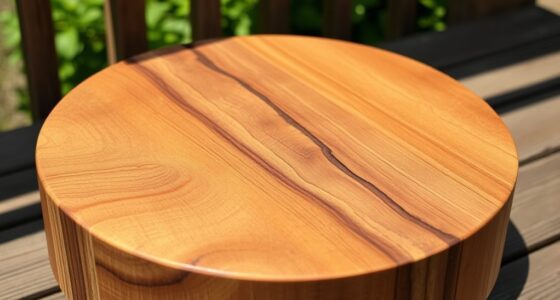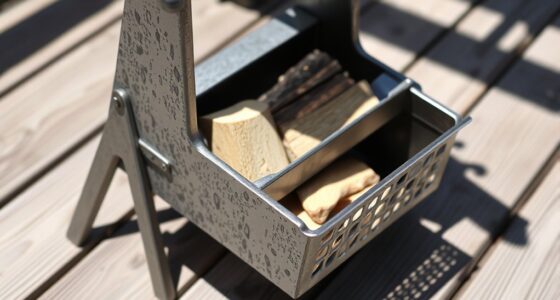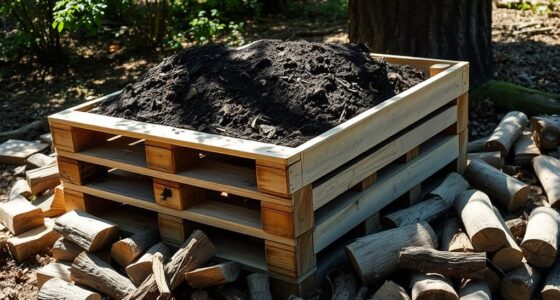To create a firewood cover from tarp and EMT, start by bending the EMT into arches or a frame that fits over your woodpile. Secure the frame firmly into the ground or weight it down to withstand weather. Drape a durable, waterproof tarp over the frame, ensuring edges extend beyond the wood to prevent rain seepage. Tighten and secure the tarp to allow airflow underneath, keeping your firewood dry, well-ventilated, and protected from the elements—learn more about perfecting your setup below.
Key Takeaways
- Use EMT to create a sturdy frame or arches that support the tarp over the firewood pile.
- Select a waterproof, durable tarp large enough to fully cover the woodstack with extra overlap.
- Secure the tarp tightly to the EMT frame using ropes or bungee cords to prevent sagging and water seepage.
- Elevate tarp edges or center to promote air circulation, reducing moisture buildup and mold risk.
- Anchor the EMT structure securely into the ground or with weights to withstand weather conditions and ensure long-term protection.

Covering your firewood properly is essential to keep it dry and ready for use, especially during wet seasons. When it comes to firewood storage, ensuring your wood stays protected from rain, snow, and high humidity is crucial for maintaining its quality and burnability. Without proper weather protection, your firewood can quickly become damp, promoting mold growth and making it harder to ignite. To achieve effective coverage, many people turn to tarps and EMT (Electrical Metallic Tubing) to create reliable, low-cost solutions that shield their wood pile from the elements.
Using a tarp is one of the simplest ways to protect your firewood. You should select a durable, waterproof tarp large enough to cover the entire stack, extending beyond the edges to prevent rain from seeping in. When covering your firewood, avoid draping the tarp loosely, as it can act like a sail and blow off in strong winds. Instead, secure it tightly with ropes, bungee cords, or weights like stones or bricks. Make sure the tarp is elevated slightly at the center or edges to allow air circulation, which is vital for preventing moisture buildup underneath. Proper air flow promotes drying and reduces the risk of mold, rot, or insect infestation, preserving the quality of your firewood over time.
In addition to tarps, EMT can be repurposed as a sturdy framework to hold covers and create a more structured shelter. By bending EMT pipes into a simple arch or frame over your woodpile, you provide a stable structure that supports a tarp without sagging. This setup not only improves weather protection but also allows air to circulate freely around the wood, reducing moisture retention. When constructing your firewood shelter, ensure the frame is securely anchored into the ground or weighted down to withstand wind and weather conditions. This method offers a long-lasting, customizable solution that keeps your firewood dry and ready for use, regardless of the season.
Frequently Asked Questions
How Long Does a Tarp and EMT Firewood Cover Typically Last?
A tarp and EMT firewood cover typically last between 1 to 3 years, depending on durability expectations and weather resistance. If you choose high-quality, UV-resistant materials, you can extend its lifespan even through harsh weather. Proper maintenance, like cleaning and ensuring it’s securely fastened, also helps. Keep in mind that exposure to extreme sun, rain, or snow can shorten its durability, so inspecting it regularly is essential.
Can This Cover Withstand Heavy Snow and Ice?
Your tarp and EMT firewood cover can generally withstand heavy snow and ice, but it depends on the material quality. Look for a cover with strong ice resistance and reinforced seams. Heavy snow accumulation might cause sagging if not properly secured, so guarantee it’s tightly fastened. Regularly remove snow buildup to prevent damage, and choose a cover designed for extreme weather conditions for best protection.
Is the Cover Suitable for Different Firewood Sizes?
Think of the cover as a flexible shield, adaptable to different firewood sizes. You’ll find it suits various firewood size, thanks to its stretchable design and adjustable features. Its flexibility guarantees your firewood stays protected, regardless of whether you’re stacking small kindling or larger logs. So, yes, this cover is suitable for different firewood sizes, making it a versatile choice for keeping your wood dry and ready to burn.
How Do I Secure the Tarp and EMT Against Strong Winds?
To secure your tarp and EMT against strong winds, you should focus on proper tarp anchoring and wind resistance techniques. Use heavy-duty stakes or weights to keep the tarp grounded, and make certain all edges are tightly secured with bungee cords or ropes. Overlap the tarp edges and fasten them firmly to prevent flapping. Regularly check and tighten the anchoring to maintain wind resistance, especially during storms.
Is This Cover Reusable After Prolonged Exposure?
Like a knight’s armor, your cover’s reusability depends on its material durability. After prolonged exposure, it might show signs of wear, tears, or fading, raising reusability concerns. If it’s made from heavy-duty, weather-resistant materials, you can likely reuse it multiple times. However, if it’s lightweight or poorly treated, its lifespan shortens. Regular inspections help determine if your cover remains strong enough to protect your firewood effectively.
Conclusion
Covering your firewood with a tarp and EMT pipe acts like a sturdy shield protecting your precious flames from nature’s relentless assault. It’s your secret recipe for dry, crackling firewood that’s ready to roar when you need it most. Think of this DIY cover as a fortress guarding your winter warmth, turning damp chaos into cozy heat. With this simple setup, your firewood stays dry and your fires stay fierce, ready to ignite your season’s comfort.









